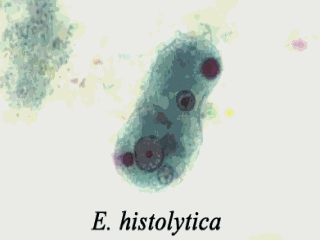 |
Entamoeba
histolytica exists in 2 life forms: the active parasite (trophozoite) and the dormant
parasite (cyst). Trophozoites live in the intestinal contents and feed on bacteria or on
the wall of the intestine. When infection begins, the trophozoites may cause diarrhea,
which expels them from the body. Outside the body, the fragile trophozoites die. When the
person doesn't have diarrhea, the trophozoites usually become cysts before leaving the
intestine. The cysts are very hardy and may spread either directly from person to person
or indirectly through food or water. Indirect transmission of the cysts is more common in
areas where sanitation is poor, such as in migrant labor camps. Fruits and vegetables may
be contaminated when grown in soil fertilized by human stool, washed in polluted water, or
prepared by someone who is infected. Infected foodhandlers are sources of new infections. |
